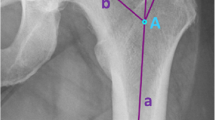Abstract
Purpose
The use of femoral stems with a short metaphyseal fixation may lead to fractures or subsidence. Such failures may be related to a mismatch between the torsions or the sagittal flares of the stem and the femur. The goal of our study was to perform a 3D analysis of the proximal metaphyseal femur anatomy with a special focus on the anterior proximal flare and torsion. Such data may help to detect the outlier patients for whom a short metaphyseal fixation should be avoided.
Methods
A prospective study included 80 consecutive patients who underwent a primary cementless THA with a 3D CT-scan based pre-operative planning. A femoral frame was determined in order to analyse the proximal metaphyseal torsion and flares of the femur.
Results
The mean metaphyseal torsion was 21.6° ± 7° at 5 mm above the lesser trochanter (LT) and 34.7° ± 8.8 at 15 mm under LT generating a differential torsion of 13° around the LT. The mean flare index was 4.3 ± 0.9 medially, 3.7 ± 0.8 laterally, 2 ± 0.6 anteriorly and 3.1 ± 0.6 posteriorly. The anterior flare was the only flare significantly correlated to the bone density, to the age and to the femoral off-set: the higher the anterior flare index, the younger the patient, the higher the bone density and the higher the femoral offset. The anterior flare was not significantly correlated to the femoral anteversion, the metaphyseal torsion and the coronal neck-shaft angle.
Conclusion
The proximal femoral metaphysis presents a highly variable anterior flare and torsion that may explain a mismatch between the femur and the femoral stem, consequently generating a risk of subsidence or fracture when using shortly fixed stems.
Level of Evidence: Level IV









Similar content being viewed by others
References
van Oldenrijk J, Molleman J, Klaver M, Poolman R, Haverkamp D (2014) Revision rate after short-stem total hip arthroplasty: a systematic review of 49 studies. Acta Orthop 85:250–258
Australian Orthopedic Association National Joint Replacement Registry (2015) Annual report. Australian registry
Maier M, Streit M, Innmann M, Krüger M, Nadorf J, Kretzer J, Ewerbeck V, Gotterbarm T (2015) Cortical hypertrophy with a short, curved uncemented hip stem does not have any clinical impact during early follow-up. BMC Musculoskelet Disord 16:371
Schmidutz F, Graf T, Mazoochian F, Fottner A, Bauer-Melnyk A, Jansson V (2012) Migration analysis of a metaphyseal anchored short-stem hip prosthesis. Acta Orthop 83:360–365
Husmann O, Rubin P, Leyvraz P, de Roguin B, Argenson J (1997) Three-dimensional morphology of the proximal femur. J Arthroplasty 12:444–450
Sariali E, Mouttet A, Mordasini P, Catonné Y (2012) High 10-year survival rate with an anatomic cementless stem (SPS). Clin Orthop Relat Res 470:1941–1949
Noble P, Alexander J, Lindahl L, Yew D, Granberry W, Tullos H (1988) The anatomic basis of femoral component design. Clin Orthop Relat Res 235:148–165
Huppertz A, Lembcke A, Sariali E, Durmus T, Schwenke C, Hamm B, Sparmann M, Baur A (2015) Low dose computed tomography for 3D planning of total hip arthroplasty: evaluation of radiation exposure and image quality. J Comput Assist Tomogr
Sariali E, Mouttet A, Pasquier G, Durante E (2009) Three dimensionnal hip anatomy in osteoarthritis. Analysis of the femoral off-set. J Arthroplast 24:990–997
Murphy S, Simon S, Kijewski P, Wilkinson R, Griscom N (1987) Femoral anteversion. J Bone Joint Surg Am 69:1169–1176
Sariali E, Mouttet A, Pasquier G, Durante E, Catonne Y (2009) Accuracy of reconstruction of the hip using computerised three-dimensional pre-operative planning and a cementless modular-neck stem. J Bone Joint Surg (Br) 91:333–340
Kobayashi H, Homma Y, Baba T, Ochi H, Matsumoto M, Yuasa T, Kaneko K (2015) Surgeons changing the approach for total hip arthroplasty from posterior to direct anterior with fluoroscopy should consider potential excessive cup anteversion and flexion implantation of the stem in their early experience. Int Orthop doi:10.1007/s00264-015-3059-1
Jewett BA, Collis DK (2011) High complication rate with anterior total Hip arthroplasties on a fracture table. Clin Orthop Relat Res 469:503–507
Lee G, Marconi D (2015) Complications following direct anterior hip procedures: costs to both patients and surgeons. J Arthroplast. doi:10.1016/j.arth.2015.03.043
Spaans AJ, van den Hout JAAM, Bolder SBT (2012) High complication rate in the early experience of minimally invasive total hip arthroplasty by the direct anterior approach. Acta Orthop 83:342–346
Sariali E, Catonné Y, Pascal Moussellard H (2016) Three-dimensional guided total hip arthroplasty through a minimally invasive direct anterior approach. Clinical outcomes at 5 years follow-up. Int Orthop doi:10.1007/s00264-016-3242-z
Flecher X, Pearce O, Parratte S, Aubaniac J, Argenson J (2010) Custom cementless stem improves hip function in young patients at 15-year followup. Clin Orthop Relat Res 468:747–755
Kniesel B, Konstantinidis L, Hirschmüller A, Südkamp N, Helwig P (2014) Digital templating in total knee and hip replacement: an analysis of planning accuracy. Int Orthop 38:733–739
Sariali E, Mauprivez R, Khiami F, Pascal Moussellard H, Catonne Y (2012) Accuracy of the preoperative planning for cementless total hip arthroplasty. A randomised comparison between three-dimensional computerised planning and conventional templating. Orthop Traumatol Surg Res 98:151–158
Author information
Authors and Affiliations
Corresponding author
Ethics declarations
Funding
No funding sources were provided for this study.
Conflict of interests
Intellectual property rights: royalties from Symbios SA
Rights and permissions
About this article
Cite this article
Sariali, E., Knaffo, Y. Three-dimensional analysis of the proximal anterior femoral flare and torsion. Anatomic bases for metaphyseally fixed short stems design. International Orthopaedics (SICOT) 41, 2017–2023 (2017). https://doi.org/10.1007/s00264-017-3435-0
Received:
Accepted:
Published:
Issue Date:
DOI: https://doi.org/10.1007/s00264-017-3435-0




